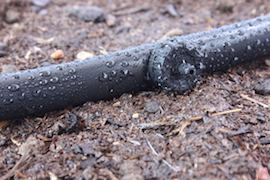As global demand for food grows and accessible freshwater resources continue to shrink, precision irrigation technology is helping farmers to save water while increasing productivity. The term precision irrigation can often refer to drip irrigation, however it can also include other tools such as variable rate application, sensors, and data from irrigation flow meters that help farmers reduce water waste. Essentially, precision irrigation is concerned with optimizing irrigation across an entire field. Here are five tools and methods that help farmers to implement precision irrigation.

Collecting data about farm conditions from tools like real-time soil moisture management systems, climate data monitors, and drones can help farmers make quick decisions to optimize their water usage. Real-time data about the soil moisture in the field can allow the farmer to apply the right amount of water based on plant needs to avoid water waste or plant stress. Drones are an early-stage technology that is pending approval from the FAA for farm use and can efficiently collect useful data such as field drainage, plant maturity, irrigation leaks, crop health, and more. Software applications can analyze data from multiple sources and provide farmers with recommendations to increase irrigation efficiency.
Drip Irrigation
A large amount of water is lost with overhead spray irrigation from evaporation and surface run-off but drip irrigation provides water directly to the root area. A study by Washington State University found that a drip system resulted in 50% less water use and 50% less weed growth. Although the challenges include greater up-front costs and more system maintenance, the advantages include lower water costs, less weed growth, and lower soil erosion potential. Farmers switching to drip irrigation have also seen increases in yields which can increase revenue per acre of farmland.
Variable Irrigation
The University of Florida describes variable irrigation as “innovative technology that enables a center pivot irrigation system to optimize irrigation application.” While uniform irrigation may overwater or underwater some areas, a variable irrigation system (VRI) can apply irrigation at different rates to different zones of the field. Management of irrigation zones is based on data collected such as soil electrical conductivity, soil moisture, topography, and aerial photos. A control system, that includes valves on sprinklers, can turn individual sprinklers on and off and vary irrigation rates.
Monitoring Irrigation Rate
After determining the optimal rate of irrigation based on data from the field, it is important to have an accurate way to measure the rate of irrigation that is being applied. Irrigation flow meters are one commonly used tool that will help monitor the water flow in an irrigation system. According to New Mexico State University, flow meters are excellent devices for measuring flow in an irrigation pipe, require little maintenance, and are usually accurate to within 2 percent.
Automated Irrigation Systems
Automated irrigation systems can take inputs like soil moisture data and crop height and adjust irrigation rates automatically. According to the University of Florida, once an automatic soil water sensor-based irrigation system is installed it can require only weekly observation and water application automatically adjusts based on plant needs and weather conditions throughout the season. A University of California experiment showed that automated irrigation system can conserve water by reducing runoff to less than 5% of applied water.
